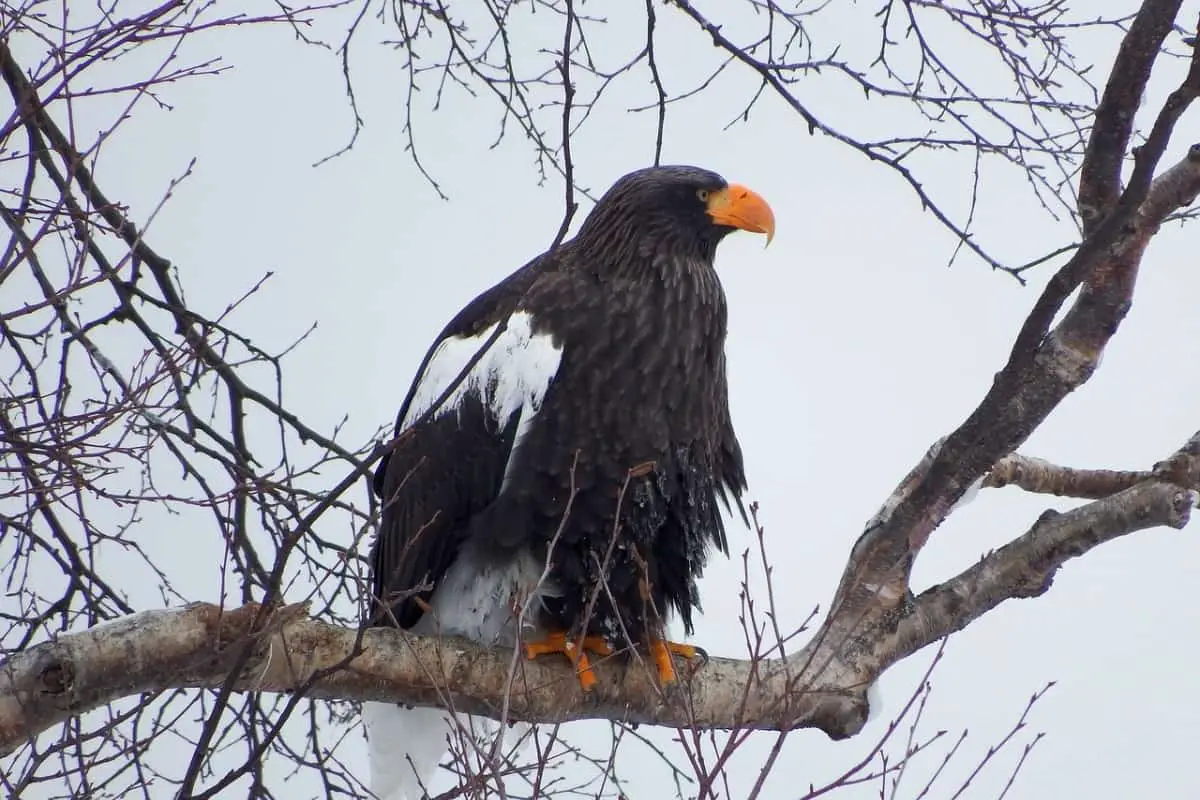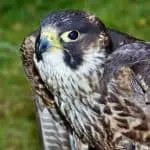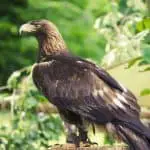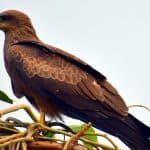Common Name: Steller's Sea Eagle
Scientific Name: Haliaeetus pelagicus| Size | Diet | Range in Hawaii | Status in Hawaii |
|---|---|---|---|
| 36 in. - 43 in. | fish and seabirds | Unknown | Vulnerable |
Steller’s sea eagle (Haliaeetus pelagicus) is a magnificent bird of prey that has captured the attention of bird enthusiasts around the world. Known for its striking appearance and powerful build, this eagle is native to Northeast Asia and is listed as vulnerable by the IUCN with only about 4,000 individuals left in the wild.
But did you know that there have been sightings of Steller’s sea eagles in Hawaii? While it is not a native species to the islands, it has been spotted occasionally, making for a rare and exciting sighting for birdwatchers in Hawaii. In this article, we’ll explore the fascinating world of Steller’s sea eagles and their unexpected presence in Hawaii.
Steller’s Sea Eagle
Appearance
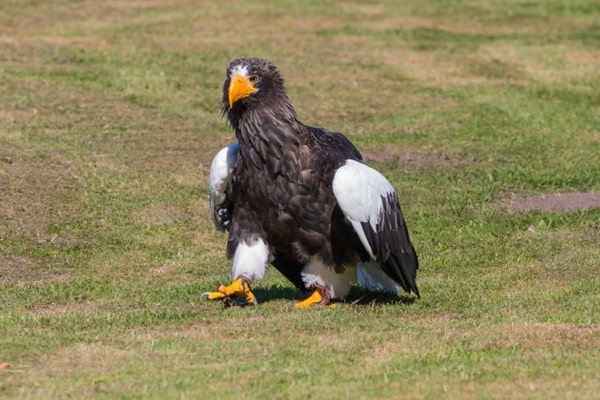
The Steller’s Sea Eagle is a magnificent bird known for its impressive size and striking appearance. It is considered one of the largest eagles in the world. On average, it measures about 36 to 43 inches (91 to 109 cm) in length, making it a truly formidable sight.
The Steller’s Sea Eagle has a distinctive plumage, characterized by a dark brown body with contrasting white feathers on its head, neck, and tail. The white feathers form a striking contrast against the dark body, creating a visually striking appearance. Additionally, adult Steller’s Sea Eagles have a large, strong, and hooked beak that is bright yellow, adding to their overall majestic presence.
Diet
The diet of the Steller’s Sea Eagle primarily consists of fish, making it a specialized piscivorous predator. As a coastal bird, it relies heavily on marine resources for its sustenance. It has been observed diving from the air or perched on a vantage point to snatch fish directly from the water’s surface.
Steller’s Sea Eagles are known to feed on a variety of fish species, including salmon, trout, and herring. They are particularly skilled at catching large fish and are capable of carrying sizable prey back to their nests or feeding sites. Their sharp, hooked beaks and strong talons enable them to grasp and secure their aquatic prey effectively.
While fish comprise the majority of their diet, Steller’s Sea Eagles are opportunistic feeders and may also scavenge on carrion or take advantage of other available food sources. This includes feeding on waterfowl, seabirds, small mammals, and even carrion washed ashore.
Nesting
The nesting behavior of Steller’s Sea Eagle is fascinating and impressive. These eagles typically build their nests in large trees near water bodies, such as rivers, lakes, or coastal areas. They prefer secluded and undisturbed locations for nesting.
The nests constructed by Steller’s Sea Eagles are massive in size, often reaching several feet in diameter and weighing hundreds of pounds. They are made primarily of sticks and branches, forming a sturdy platform that can withstand the weight of both the eagles and their growing chicks. Over time, additional materials such as grass, moss, and seaweed may be added to the nest, further reinforcing its structure.
Steller’s Sea Eagles are known for reusing their nests year after year, often adding to them and making necessary repairs. As a result, these nests can become quite substantial and can be used by multiple generations of eagles.
Breeding pairs of Steller’s Sea Eagles are monogamous and exhibit strong territorial behavior around their nesting sites. Both the male and female participate in nest-building, incubation, and raising their offspring. A typical clutch consists of one to three eggs, which are incubated for approximately 38 to 45 days.
Once the eggs hatch, the parents diligently care for their chicks, providing them with food and protection. The young eaglets grow rapidly and are dependent on their parents for several months before they fledge and become capable of independent flight.
Behavior
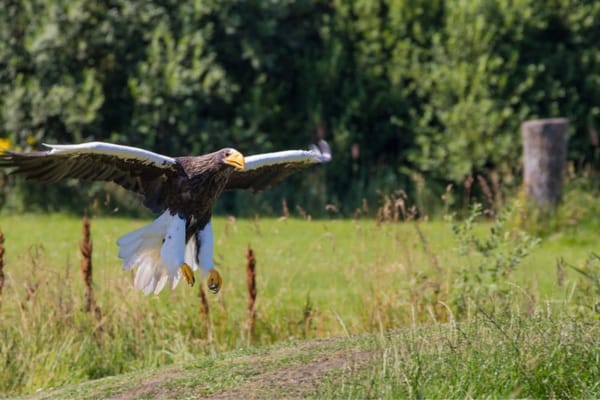
The behavior of Steller’s Sea Eagle is characterized by its powerful and majestic presence. These eagles are known for their remarkable flying abilities, keen hunting skills, and territorial nature.
Steller’s Sea Eagles are primarily solitary birds, often seen perched on trees or soaring high in the sky. They have large wingspans, which can reach up to 7.5 to 8 feet (2.3 to 2.5 meters), allowing them to glide effortlessly and cover long distances in search of prey.
These eagles are skilled hunters, specializing in capturing fish from the water’s surface. They use their sharp eyesight to spot fish from great heights and then dive down with incredible speed and precision to snatch their prey. Steller’s Sea Eagles have strong beaks and talons that help them grasp and carry their catches back to their nests or feeding sites.
During the breeding season, Steller’s Sea Eagles exhibit territorial behavior. They establish and defend their nesting sites, often engaging in aerial displays, calling, and aggressive interactions with other eagles that come too close to their territory. Breeding pairs of Steller’s Sea Eagles are monogamous, and both parents participate in nest-building, incubation, and raising their offspring.
These eagles are also known for their longevity, with individuals capable of living up to 30 years or more in the wild. Their lifespan, combined with their slow reproductive rate, emphasizes the importance of their survival and conservation.
Habitat
The Steller’s Sea Eagle inhabits a specific and unique habitat that is crucial for its survival. These majestic eagles are primarily found in coastal regions, particularly in the northern parts of Eurasia, including Russia and Japan.
Their preferred habitats include areas near large bodies of water, such as rivers, lakes, estuaries, and coastal shorelines. Steller’s Sea Eagles are specifically associated with areas that have abundant fish populations, as they heavily rely on fish as their primary food source.
They often select nesting sites in mature forests near their preferred water bodies. These forests provide suitable perching locations and nesting trees, which are usually tall and sturdy. Steller’s Sea Eagles prefer nesting in undisturbed and secluded areas, away from human activity and disturbances.
Their coastal habitat offers a variety of prey opportunities, including fish species like salmon, trout, and herring, which are plentiful in these marine environments. The availability of these fish-rich habitats is essential for the survival and successful reproduction of Steller’s Sea Eagles.
It is worth noting that Steller’s Sea Eagles are highly migratory, with breeding populations found in Siberia and wintering populations in Japan. Their migratory behavior is tied to the availability of food and suitable breeding grounds.
Range
The Steller’s Sea Eagle is a species typically found breeding in Siberia and wintering in Japan. However, occasional sightings of this majestic bird have occurred in the Hawaiian Islands, specifically in the Northwestern Hawaiian Islands. Two individuals of the species have been recorded at three different atolls in the region. These sightings highlight the sporadic presence of Steller’s Sea Eagles as rare visitors to the Hawaiian Islands.
Conservation Status

The conservation status of Steller’s Sea Eagle is currently categorized as “Vulnerable” by the International Union for Conservation of Nature (IUCN). This indicates that the species faces a high risk of extinction in the wild if conservation efforts are not effectively implemented.
There are several factors contributing to the vulnerable status of Steller’s Sea Eagle. Habitat loss and degradation, primarily due to human activities such as logging and infrastructure development, pose significant threats to their nesting and foraging areas. Disturbance from human presence and disturbance to their nesting sites can also have negative impacts on their breeding success.
Interesting Facts
1. Unique plumage
These eagles have a striking appearance with a dark brown body and contrasting white feathers on their head, neck, and tail. Their bright yellow beak provides an eye-catching contrast against their dark plumage.
2. Monogamous pairs
Steller’s Sea Eagles exhibit monogamous breeding behavior, forming long-term pair bonds. Both the male and female participate in nest-building, incubation, and raising their offspring.
3. Migratory behavior
Steller’s Sea Eagles are migratory birds. Breeding populations are found in Siberia, Russia, while they winter in coastal areas of Japan, where they have access to open water and ample food resources.
4. Remote breeding habitat
Breeding pairs of Steller’s Sea Eagles select remote and secluded locations for nesting, usually in mature forests near water bodies. These nesting sites offer protection and suitable perching spots for hunting and raising their young.
Frequently Asked Questions
1. Are Steller’s Sea Eagles social birds?
Steller’s Sea Eagles are generally solitary birds, except during the breeding season when they form monogamous pairs. Outside of the breeding season, they tend to be solitary hunters and can be territorial around their nesting sites.
2. Are Steller’s Sea Eagles related to bald eagles?
Steller’s Sea Eagles and bald eagles are both members of the Haliaeetus genus, which includes sea eagles. They are closely related but represent separate species. Steller’s Sea Eagles have distinct physical characteristics that set them apart, such as their larger size and unique plumage.
3. How do Steller’s Sea Eagles communicate?
Steller’s Sea Eagles use a combination of vocalizations and visual displays to communicate. They have a variety of calls, including high-pitched whistles, screeches, and soft chattering sounds. Visual displays, such as aerial acrobatics and posturing, are often used during territorial interactions or courtship rituals.
4. Can Steller’s Sea Eagles be kept as pets?
Steller’s Sea Eagles are protected species, and it is illegal to keep them as pets. They require specialized care and habitat that cannot be replicated in a domestic setting. Conservation efforts focus on preserving their wild populations and natural habitats.
